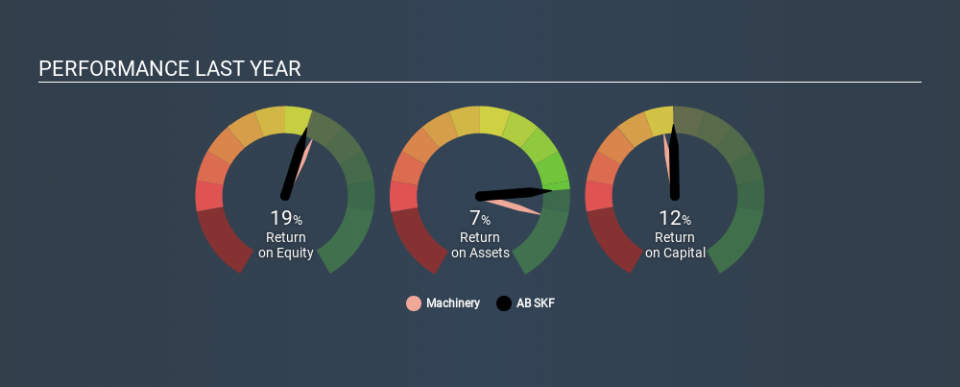How Do AB SKF (publ)’s (STO:SKF B) Returns Compare To Its Industry?

Today we'll evaluate AB SKF (publ) (STO:SKF B) to determine whether it could have potential as an investment idea. Specifically, we're going to calculate its Return On Capital Employed (ROCE), in the hopes of getting some insight into the business.
First up, we'll look at what ROCE is and how we calculate it. Next, we'll compare it to others in its industry. And finally, we'll look at how its current liabilities are impacting its ROCE.
What is Return On Capital Employed (ROCE)?
ROCE measures the 'return' (pre-tax profit) a company generates from capital employed in its business. Generally speaking a higher ROCE is better. Ultimately, it is a useful but imperfect metric. Author Edwin Whiting says to be careful when comparing the ROCE of different businesses, since 'No two businesses are exactly alike.
How Do You Calculate Return On Capital Employed?
Analysts use this formula to calculate return on capital employed:
Return on Capital Employed = Earnings Before Interest and Tax (EBIT) ÷ (Total Assets - Current Liabilities)
Or for AB SKF:
0.12 = kr8.9b ÷ (kr97b - kr22b) (Based on the trailing twelve months to September 2019.)
So, AB SKF has an ROCE of 12%.
See our latest analysis for AB SKF
Does AB SKF Have A Good ROCE?
When making comparisons between similar businesses, investors may find ROCE useful. In this analysis, AB SKF's ROCE appears meaningfully below the 15% average reported by the Machinery industry. This could be seen as a negative, as it suggests some competitors may be employing their capital more efficiently. Separate from AB SKF's performance relative to its industry, its ROCE in absolute terms looks satisfactory, and it may be worth researching in more depth.
You can see in the image below how AB SKF's ROCE compares to its industry. Click to see more on past growth.
Remember that this metric is backwards looking - it shows what has happened in the past, and does not accurately predict the future. ROCE can be misleading for companies in cyclical industries, with returns looking impressive during the boom times, but very weak during the busts. ROCE is, after all, simply a snap shot of a single year. Since the future is so important for investors, you should check out our free report on analyst forecasts for AB SKF.
AB SKF's Current Liabilities And Their Impact On Its ROCE
Current liabilities include invoices, such as supplier payments, short-term debt, or a tax bill, that need to be paid within 12 months. Due to the way the ROCE equation works, having large bills due in the near term can make it look as though a company has less capital employed, and thus a higher ROCE than usual. To check the impact of this, we calculate if a company has high current liabilities relative to its total assets.
AB SKF has total assets of kr97b and current liabilities of kr22b. As a result, its current liabilities are equal to approximately 23% of its total assets. Current liabilities are minimal, limiting the impact on ROCE.
The Bottom Line On AB SKF's ROCE
Overall, AB SKF has a decent ROCE and could be worthy of further research. AB SKF looks strong on this analysis, but there are plenty of other companies that could be a good opportunity . Here is a free list of companies growing earnings rapidly.
I will like AB SKF better if I see some big insider buys. While we wait, check out this free list of growing companies with considerable, recent, insider buying.
If you spot an error that warrants correction, please contact the editor at editorial-team@simplywallst.com. This article by Simply Wall St is general in nature. It does not constitute a recommendation to buy or sell any stock, and does not take account of your objectives, or your financial situation. Simply Wall St has no position in the stocks mentioned.
We aim to bring you long-term focused research analysis driven by fundamental data. Note that our analysis may not factor in the latest price-sensitive company announcements or qualitative material. Thank you for reading.


